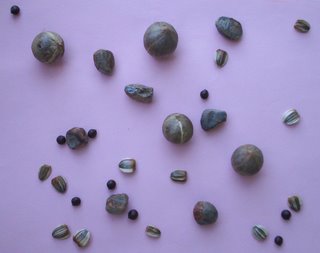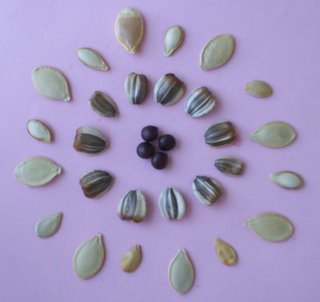
From the tiny veronicas that inhabit lawns and meadows to the giant sequoias of the Sierras, almost all flowering plants set seed. Gardeners with the patience to unlock the secrets of seeds can grow almost any flowering plant no matter how large or small. The key is understanding the needs of each variety you wish to grow.
While most seeds will be happy to take right off when planted in fairly warm soil and kept evenly moist, some seeds require a little more consideration. You can start by planting out only a portion of the seeds in a packet, to see how they will do, or you can do a little research first.
Many seeds will only germinate within narrow temperature ranges. For instance, most common summer vegetables need fairly warm soil temperatures. And soil temperature is often quite different than the temperature of the air. Other seeds have genetically coded dormancy periods that require a specific cold wet time period to stimulate germination. Some seeds need light and others need dark.
Fortunately, for most plants, this information is known and it is usually listed in seed catalogs or on the seed packages. But not always. Resources are listed at the end of the article just in case you are having trouble getting any of your treasured seeds to grow. Meanwhile, here are some basic tips and short cuts to help you unlock the secrets of seeds.
Large Seeds:
 Larger seeds, like those from squash and pumpkins, generally germinate and grow quickly. They have a large store of energy to begin their life and are ready to spring into action. All they ask is a warm moist place to sink their roots and adequate sun light to start growing. A warm sunny window or porch makes a good starting place, or they can be planted out in the garden after the soil surface feels warm to the touch. I like to start a few seeds at a time – knowing full well that those I start before the soil warms up may not survive. But if they do and I get an early crop, that makes me smile.
Larger seeds, like those from squash and pumpkins, generally germinate and grow quickly. They have a large store of energy to begin their life and are ready to spring into action. All they ask is a warm moist place to sink their roots and adequate sun light to start growing. A warm sunny window or porch makes a good starting place, or they can be planted out in the garden after the soil surface feels warm to the touch. I like to start a few seeds at a time – knowing full well that those I start before the soil warms up may not survive. But if they do and I get an early crop, that makes me smile.There are exceptions to the large – quick rule. A common one is seed with hard or thick seed coats. Gourds and many trees and shrubs fall into this category. Often all that is necessary to get these seeds to grow is a well placed nick through the seed coat and a nice soak in tepid water over night. (When nicking seed coats it is important to avoid the portion that contains the plant embryo. Ask a gardening buddy for advice on this.) Some thick shelled seeds need to be cold stratified, or have other specific germination regimes. This, however, is more the concern of ornamental gardeners than vegetable gardeners.
Small Seeds:

Small seeds generally take longer to develop into vigorous plants, and the smaller the seed, the more tender loving care the young plant will need. Tomatoes can take four to six weeks from starting before they are ready to face down slugs in the garden, while our hearty pumpkins may be prepared to brave the real world in as little as two or three weeks. Tomatoes and other small seeded plants have limited food stored, so quality seed starting medium or potting soil, supplemental feeding, and lots of the right kind of light is essential.
Seed Starting Mediums:
Unless you have the time and energy to experiment, purchasing sterile seed starting medium is the way to go. These products are all ready screened, contain no weed seeds, bug eggs, or disease pathogens. For those on a limited budget, screened, sterilized compost or leaf-mold can be pressed into use. Make sure your material is well decomposed and all large pieces are removed. You can mix in a bit of sand if you like, to improve drainage. If we get a sunny day you can sterilize your mix outdoors. Evenly moisten your medium, spread it in an old metal baking pan, filling the pan to the top and gently tamping it down. Cover tightly with clear plastic wrap and place in the sun on a warm surface. An old car, or an asphalt, cement, or rock surface works well. Leave in the sun for the day, and your mix is ready to use.
Supplemental Plant Food:
Young seedlings can be feed fish emulsion (get the deodorized kind if you are keeping the plants inside), tea made from alfalfa pellets, diluted coffee, or commercial seed starting food. Fish emulsion and seed starting food are available through most seed catalogs and plant nurseries and will have directions on the label. For do it your selfers: One cup of brewed coffee, diluted, makes a full quart of seedling food and can be used once or twice a week. A handful of alfalfa pellets thrown into a gallon of water and left in the sun makes a nice supplemental plant food that can also be used once or twice a week. Some folks prefer manure or compost tea. More information on these can be found by searching on the Internet.
Light:
Plants need ultraviolet light to grow. The best source is the sun. However, grow lights and full spectrum lights are available for those of us who want to get an early start when our weather won’t allow it. If you are not ready to set up supplemental light, limit your early seed starting to sunny porches and windows. Start a few seeds at a time, and enjoy your fresh produce over a long season.
Space Saving Germination Trick:
My favorite way to start seeds is in zip lock bags. You can keep the seeds evenly moist without any effort, and it is easy check on the emerging seedlings progress. Layer 2 – 4 pieces of bathroom tissue over four pieces of newspaper cut to size. Moisten the stack, and evenly place 6 – 12 seeds on the surface. Slip this into a clean used (or new) reclosable sandwich sized bag. You can store a stack of these baggies in an evenly warm place, away from direct heat. Be sure to check daily. When the seedlings have developed their first seed leaves carefully remove the paper from the bag, and carefully transfer the seedlings to six packs or small pots of potting soil or seed starting medium. By starting seeds this way I find I get better germination rates, better seedling survival rates, and it definitely saves space.
Soil Thermometers:
A soil thermometer is a good investment for anyone serious about growing a large number of plants from seeds, particularly if you are interested in rare or exotic plants. They are also useful to the serious vegetable gardener. Most vegetables germinate best when the soil is between 70 – 90 degrees. Soil thermometers can be found for around $10.00 through many seed catalogs and plant nurseries.
On Line Resources:
The Seed Site
http://theseedsite.co.uk/seedpods.html
Scroll to the bottom of the page for links to information on germination, seed sowing, and seedlings. This site lists more varieties of seeds than most of us will grow in a life time.
Vegetable Germination Temperatures
http://www.heirloomseeds.com/germination.html
Easy to use chart gives soil temperature ranges for germination of commonly grown vegetables.
Books:
The Seed Starter’s Handbook, by Nancy Bubel, published by Rodale Press. Everything the serious vegetable gardener needs to know about starting their own seeds, from soil temperatures, days to germination, and much more.
Save Your Own Seed, By Lawrence D. Hill, published by The Henry Doubleday Research Association. This is a very cool little book that includes a chart on how long vegetable seeds can be saved. It is kind of surprising, some get old pretty quickly and some kinds can last for years.
Growing California Native Plants, by Marjory G. Schmidt, published by California Natural History Guides. Lots of information here on growing ornamental wild plants in the home landscape.
For more information see http://harvestsgardeningsecrets.blogspot.com and stay tuned, next week we will be exploring the wonderful uses of sweet alyssum. Mean while, you can probably find me out in the garden Digging the Dirt.
Copyright 2006 Harvest McCampbell
Published by the Hoopa Valley People Newspaper May 30, 2006
Posted here with permission
No comments:
Post a Comment